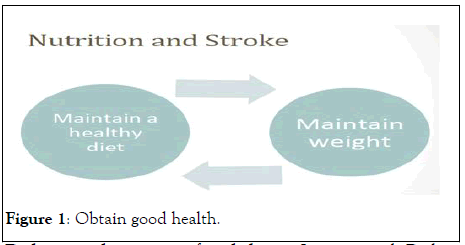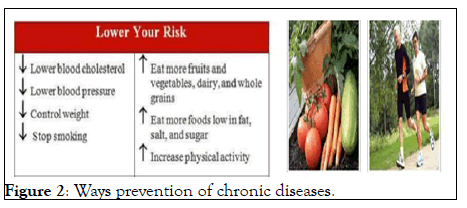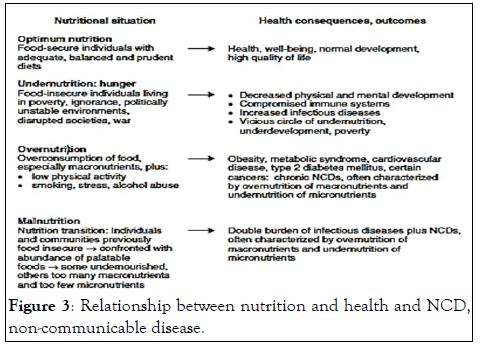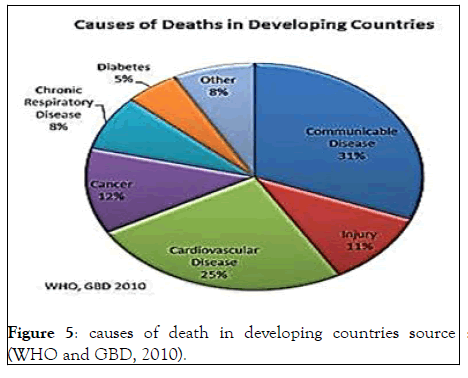Journal of Nutrition & Food Sciences
Open Access
ISSN: 2155-9600
ISSN: 2155-9600
Review Article - (2022)Volume 12, Issue 7
Chronic diseases is disease of over consumption eating too much fat, saturated fat, salt and sugar, cholesterol and not eating enough vegetables, fruits, and cereals fiber. Chronic diseases are global health problems, and cause death and disability to millions of people. Therefore, the aim of this review paper is to review and summarizes studies made by numerous researchers on nutrition management of chronic diseases. Selection of food is very important to manage chronic diseases. Dietary intake of phytochemicals especially fruits and vegetables including grains may promote health benefits, protecting against chronic diseases. Most of peoples are eating nutritional habits lead to chronic diseases such as High fat diets, low vitamin/mineral intake, excessive alcohol intake, high sugar intake, low carbohydrate intake, high salt intake. However consumption of phytochemical and grains are associated with a decrease in risk of several types of chronic diseases due to their antioxidants and free radical scavenging effects. The nutritional and health value of fruits and vegetables is well recognized, because they play important roles in human health by way of providing antioxidants that are important in neutralizing free radicals (oxidants) known to cause chronic disease. Generally the consumption of fruits, vegetables and grain cereals have great role in managing of chronic diseases. So to manage chronic disease, avoid from consumption of food and beverage which has high fat, sugar, salt, too much alcohol drinking and eating of phytochemicals especially fruits and vegetables as well as working regular physical activities are very important.
Chronic disease; Fruits and vegetables; Phytochemicals
Background information
Chronic disease is disease that persists over a long period of time. It is a disease that affect the sufferer over a long period of time and that generally progress slowly. Chronic diseases or Noncommunicable diseases are now the leading cause of mortality worldwide and they are responsible for 70% of global deaths equivalent to 40 million people. Numerous studies are showing that, nutrition and health are closely related. Limiting intake of saturated fats and eating ample amount of fruits and vegetables can all reduce the risk for many different chronic diseases. Currently, the developing countries are afflicted with the dual burden of disease non-communicable and Noncommunicable diseases are more and more prevalent in developing countries. It is projected that, in near future,NCDs will account for nearly 70% of the mortality in developing world. There is growing attention for chronic diseases in Sub-Saharan Africa (SSA) for the management of chronic diseases. This becomes more urgent with increasing numbers of people living with chronic conditions. The strong advocacy for managing non-communicable diseases appropriately, many of which are life-long, and the more general focus on health systems strengthening has catalyzed attention for chronic care. Economic development is normally accompanied by improvements in a country’s food supply and the gradual elimination of dietary deficiencies, thus improving the overall nutritional status of the country’s population [1-10]. Therefore, chronic disease management is essential to both improving health outcomes of poor individuals, increase quality of life for the patient and decrease cost effective from the provider.
Poor quality and efficient diets are the factors contributing to the global burden of disease. Specifically, the NCD load is associated with diets low in fruits and vegetables, low in whole grains. The most common chronic diseases are heart disease, cancer, and chronic lung disease, stroke, and diabetes and kidney disease. They come from some dietary and lifestyle practices (smoking, inactivity, and too much drinking alcohol). Diets and nutritional status are important determinants of noncommunicable diseases and it is because of healthy diets boost good cholesterol and decrease unhealthy triglycerides. Recently, it is clearly known that phytochemical have role in the protection of human health, when their dietary intake is significant. Cereals and phytochemical (fruits and vegetables) consumption are associated with a decrease in risk of several types of chronic diseases due to their antioxidant and free radical scavenging effects, as well as anti-inflammatory action. Dietary intake of phytochemicals may promote health benefits, protecting against chronic degenerative disorders, such as cancer, cardiovascular and neurodegenerative diseases.
The majority of people have their health affected by lifestyle choices. A poor diet and inactive lifestyles are known to be risk factors for life threatening diseases. More recently, nutrition research has focused on chronic diseases which are disease of over-consumption eating too much fat, saturated fat and cholesterol and not eating enough vegetables, fruits, cereals, and fiber has been connected to an increase in heart disease and other are associated with energy and nutrient excess. Disease of over-consumption are once thought to be rich countries problem, chronic diseases have now become epidemic in developing countries as well-contributing to three out of five death worldwide.
Chronic disease management has emerged as a new strategy for chronic disease care. Chronic diseases are global health problems, and cause death and disability to millions of people. The fact that dietary pattern or certain foods affect our health will determine by conducting nutritional research based on the scientific method and selection of food [11-19]. Appropriate dietary practices, increased physical activity, abstinence from tobacco/substance use and alcohol abuse play an important role in their prevention and management. What we eat and our nutritional status can affect chronic diseases. To manage chronic diseases selection of food is very important. It has been demonstrated that fruits, vegetables and grains exert a protective effect against the development of chronic diseases. Avoid to eat food contain high fat, oil, salt and sugar, too much drink alcohol and consume more of fruits and vegetables, cereals and doing regular physical activities are necessary. However most of people are not choose foods that are important for their healthy to avoid and reduce chronic disease [20-25].
Therefore, the aim of this review paper is to review studies made by several researches and reviews on nutritional management of chronic disease.
Chronic diseases and their causes
A non-communicable disease is a noninfectious health condition that cannot be spread from person to person. It is chronic disease is a human health condition or disease that is persistent or otherwise long-lasting in its effects or a disease that comes with time. Many chronic diseases are caused by a short risk behaviors: Tobacco use and exposure to second hand smoke; Poor nutrition, including diets low in fruits and vegetables and high in sodium and saturated fats; Lack of physical activity and excessive alcohol use.
According to report of WHO by 2020, chronic diseases will account for almost three-quarters of all deaths worldwide, and that 71% of deaths due to Ischemic Heart Disease (IHD), 75% of deaths due to stroke, and 70% of deaths due to diabetes will occur in developing countries. The number of people in the developing world with diabetes will increase by more than 2.5 fold, from 84 million in 1995 to 228 million in 2025.
On a global basis, 60% of the burden of chronic diseases will occur in developing countries. Adults who eat a healthy diet live longer and have a lower risk of obesity, heart disease, type 2 diabetes, and certain cancers. Healthy eating can help people with chronic diseases manage these conditions and prevent complications.
An illness which is lifelong because it ends in death is a terminal illness. It is possible and not unexpected for an illness to change in definition from terminal to chronic. Four common behavioral risk factors (tobacco use, excessive alcohol consumption, poor diet, and lack of physical activity) are associated with disease clusters (cardiovascular diseases, cancers, chronic pulmonary diseases, and diabetes) that account for about 80% of deaths from non-communicable diseases.
As reviewed, global trends in the prevalence of these behavioral risk factors and intermediate phenotypes portend substantial increases in most of the non-communicable diseases worldwide, with the patterns of change in incidence varying between and within regions, depending on the level of economic development, the pace of the demographic transition from high birth and death rates to low birth and death rates, and the prevalence of risk factors. Eating a healthy diet, along with getting enough physical activity and sleep, can help children grow up healthy and prevent overweight and obesity. In the United States, 19% of young people aged 2 to 19 years and 40% of adults have obesity, which can put them at risk for heart disease, type 2 diabetes, and some cancers. An unhealthy diet can increase the risk of some cancers. Overweight and obesity are associated with at least 13 types of cancer, including endometrial (uterine) cancer, breast cancer in postmenopausal women, and colorectal cancer [26-38].
Chronic liver disease: Liver has a central role in nutritional homeostasis and any liver disease leads to abnormalities in nutrient metabolism and subsequent malnutrition. All children with Chronic Liver Disease (CLD) must undergo a periodic nutritional assessment medical history, anthropometry esp. skinfold thickness and mid-arm circumference, and biochemical estimation of body nutrients. Proteins rich in branched chain amino acids are given in moderation (2–3 gm/kg/day) in compensated cirrhotic unless encephalopathy occurs when protein restriction may be necessary (1 gm/kg/day). Fat-soluble vitamins are supplemented in large quantities esp. in cholestasis along with other vitamins and minerals. Dietary therapy is the mainstay of management of some metabolic liver diseases and may be curative in disorders like galactosemia, fructosemia and glycogen storage disorders. Pre and postoperative nutritional support is an important factor in improving survival after liver transplantation. Excessive alcohol consumption is the main dietrelated risk factor for liver cancer in industrialized countries.
Heart disease and stroke: Coronary heart disease is the most important manifestation of arteriosclerosis in humans and belongs to the large group of cardiovascular diseases. CHD is still the single largest cause of premature death in the world. Heart disease is the leading cause of death in the United States. It develops when atherosclerosis causes narrowing of the coronary arteries and decreased flow of oxygen and nutrients to the heart.
Diets and heart disease where we have been saturated fat, cholesterols and vegetables oils. Ischemic heart disease has been estimated to account for 12 % of all deaths worldwide in 2004. Two of the leading causes of heart disease and stroke are high blood pressure and high blood cholesterol. Consuming too much sodium can increase blood pressure and the risk for heart disease and stroke. Current guidelines recommend getting less than 2,300 mg a day, but Americans consume more than 3,400 mg a day on average. Over 70% of the sodium that Americans eat comes from packaged, processed, store bought, and restaurant foods. Eating foods low in saturated fats and high in fiber and increasing access to low-sodium foods, along with regular physical activity, can help prevent high blood cholesterol and high blood pressure. Stroke is one of the major causes of death in the world. In 2004, 9.7% of all deaths were caused by stroke. Eat a diet rich in fruits, vegetables and whole cereals grains. This provides potassium and fiber, both clearly linked to reduced chronic disease risk. To control problems of heart diseases don’t add salt during food preparation; Cook with very minimal fats and oils; Control blood pressure and blood sugar.
Diabetes: Diabetes is a disease that develops when the body is unable to produce or respond to insulin hormone in the normal way. In diabetes, blood glucose rises after a meal and remains above normal levels because insulin is either inadequate or ineffective. Elevated blood glucose is a characteristic of two main types of diabetes. Type 1 diabetes is less common than type 2 diabetes, occurs when the body fails to produce insulin. Type 2 diabetes is more common, occurs when the body fails to respond to insulin in a normal way. This leads to the overproduction of insulin, which may result in a partial failure of the insulin-producing cells of the pancreas. Diabetes can lead to serious complications including blindness, kidney failure, heart disease, and strokes. According to the International Diabetes Federation, the diabetes prevalence in the 20 to 79 year olds was 6.4 % for women (Figure 1).

Figure 1: Obtain good health.
Diabetes and nutrition for diabetes: International Diabetes Federation a well-balanced, healthy eating plan is the cornerstone of good blood sugar control for all people with diabetes. Whether you are being treated with insulin or tablets, you still need to follow a sensible eating plan. The so called "diabetic diet" is not in fact a diet, but rather a healthy eating plan ideal for the whole family. Eating healthily not only helps to control blood sugar levels (thus also delaying the onset of diabetes-related complications). Carbohydrates are bad for diabetes. Carbohydrates have the greatest effect on blood sugar levels, so you will need to monitor how man you eat. But your body needs carbohydrates to get many essential nutrients. Research shows that before the introduction of insulin therapy, medical nutrition therapy was the only option of therapy for diabetic patients.
Consumption of more fruits and vegetables importance for prevention of diabetes chronic diseases. This is due to they contain vitamins, minerals, fiber, other nutrients. This occur due to a lack of insulin (a hormone), which controls blood glucose levels and an inability of the body’s tissues to respond properly to insulin (a state called insulin resistance). Avoids sugar heavy foods such as candy, soft drinks, desserts, cookies syrups honey, jams, and jellies (Figure 2).

Figure 2: Ways prevention of chronic diseases.
Diets and cancer: In 2008, about 2,457,610 new cases of cancer were observed in the European Union. The occurrence of cancer as a whole is increasing with age and the pathogenesis often takes several decades. Tobacco is the second largest cause of deaths and DALYs worldwide, and tobacco control could prevent about a third of all deaths from cancer in the United States and could also rapidly reduce deaths from cardiovascular and chronic pulmonary diseases. Some studies have suggested that risk is increased by high intakes of meat, and reduced by high intakes of vegetables. Consumption of alcoholic beverages is not recommended: if consumed, do not exceed two units per day. Do not consume foods or drinks when they are at a very hot (scalding hot) temperature.
Chronic kidney disease: The two main causes of chronic kidney disease are diabetes and high blood pressure, which are responsible for up to two-thirds of the cases. Diabetes happens when your blood sugar is too high, causing damage to many organs in your body, including the kidneys and heart, as well as blood vessels, nerves and eyes.
Chronic kidney disease progresses, the accumulation of nitrogen containing products from dietary and intrinsic protein catabolism may distort taste and smell and blunt appetite. Given that approximately 10% of the adult population worldwide has chronic kidney disease. Healthy eating for diabetes includes whole grains cereals, lean proteins foods and fruits.
Role of protein, vitamins and trace elements dietary constituents in kidney disease: Whether the quantity or quality of ingested protein is a risk factor for incident kidney disease has been debated for nearly a century. Experimental evidence suggests that long-term dietary protein intake exceeding 1.5 g per kilogram of ideal body weight per day may cause glomerular hyper filtration and proinflammatory gene expression which are known risk factors for kidney. This critical review on the associations between the intake of vegetables and fruit and the risk of several chronic diseases shows that a high daily intake of these foods promotes health. The promotion of vegetable and fruit consumption by nutrition and health policies is a preferable strategy to decrease the burden of several chronic diseases in Western societies. A micronutrient imbalance in patients with kidney disease may contribute to a higher burden of oxidative stress, inflammation, and cardiovascular disease. A recent study showed that 800 μg of folic acid per day, when added to enalapril, led to slower disease progression than enalapril given alone.
Preventing chronic diseases
Phytochemicals and their prevention of chronic disease: Phytochemicals are not essential nutrients and are not required by the human body for sustaining life, but have important properties to prevent or to fight some common diseases. Plants produce phytochemicals to protect themselves, but recent researches demonstrate that many phytochemicals can also protect human against diseases. Phytochemicals have been promoted for the prevention and treatment of diabetes, high blood pressure, and macular degeneration (Table 1). It has been demonstrated that fruits, vegetables and grains exert a protective effect against the development of these chronic diseases. This protective role can be mainly attributed to the antioxidant phytochemicals. Carotenoids have been known to have important beneficial properties for human health. Although the antioxidant properties of some carotenoids have been studied the most other mechanisms such as their pro-vitamin and activity; immune, endocrine and metabolic activities; and their role in cell cycle regulation, apoptosis and cell differentiation are also under intense scientific scrutiny (Figure 3).
| Phytochemicals | Source plant | Health benefits |
|---|---|---|
| Carotene | Carrots, leafy greens and red, orange and yellow vegetables, and pumpkin | Enhances release of immunogenic cytokines IL-1 and TNF-α, provides cornea protection against UV light, and stimulates DNA repair enzymes |
| Lycopene | papaya, pink guava, tomato, and watermelon | Lowers risk prostate cancer |
| Phytosterol | Soybean | Anti-cancer, hypolipidemic, and prevention of osteoporosis |
| Flavonoids | Legumes, grapes, fruits, and vegetables. Especially green vegetables, onion, apple | Anti-bacterial, anti-oxidant, anti-inflammatory, anti-viral, and ant proliferative |
| Polyphenols | Cereals, legumes ,fruits, vegetables, and beverages (fruit juices, and wine) | Anti-oxidant, anti-carcinogenic, anti-inflammatory, anti-diabetic |
Table 1: Phytochemical and health benefits.

Figure 3: Relationship between nutrition and health and NCD, non-communicable disease.
Nutrition for chronic disease prevention and treatment: According to the WHO 2020, chronic diseases will account for almost three quarters of all world death and that 71% of death due to ischemic heart disease, 75% of death due to stroke and 70% of death due to diabetes will occur in developing countries. Nutrition is a widely accepted tool for prevention of chronic diseases. It also very important for management and treatment of chronic diseases. Good nutrition is key to preventing and correcting the obesity epidemic worldwide. Ensure generous consumption of fruits and vegetables and adequate folic acid intake. Strong evidence indicates that high intakes of fruits and vegetables will reduce the risk of CAD and stroke.
Consume cereal products in their whole-grain, high-fiber form and limit consumption of sugar and sugar-based beverages: Consuming grains in a whole-grain, high-fiber form has double benefits. First, consumption of fiber from cereal products has consistently been associated with lower risks of type 2 which may be because of both the fiber itself and the vitamins and minerals naturally present in whole grains. High consumption of refined starches exacerbates the metabolic syndrome and is associated with higher risks of type 2 diabetes. Second, higher consumption of dietary fiber also appears to facilitate weight control and helps prevent constipation. Sugar (free sugars refined from sugarcane or sugar beets and high fructose corn sweeteners) has no nutritional value except for calories and, thus, has negative health implications for those at risk of overweight. Furthermore, sugar contributes to the dietary glycemic load, which exacerbates the metabolic syndrome and is related to the risk of diabetes and CAD. WHO has suggested an upper limit of 10 percent of energy from sugar, but lower intakes are usually desirable because of the adverse metabolic effects and empty calories (Figure 4).

Figure 4: A guide to food groups and their nutrients: source.
Economic effects
The economic consequences of non-communicable diseases are huge, because of the combined burden of health care costs and lost economic productivity due to illness and premature deaths (Figure 5, Table 2).
| Dietary and lifestyle factors | CVD | Type 2 diabetes | Cancer | Dental disease | Fracture | Cataract | Birth defects |
|---|---|---|---|---|---|---|---|
| Avoid smoking | ↓ | ↓ | ↓ | ↓ | ↓ | ↓ | |
| Pursue physical activity | ↓ | ↓ | ↓ | ↓ | |||
| Avoid overweight | ↓ | ↓ | ↓ | ↑ | ↓ | ||
| Diet | |||||||
| Consume healthy types of fatsa | ↓ | ↓ | |||||
| Eat plenty of fruits and vegetables | ↓ | ↓ | ↓ | ↓ | ↓ | ||
| Replace refined grains with whole grains | ↓ | ↓ | |||||
| Limit sugar intakeb | ↓ | ↓ | ↓ | ||||
| Limit excessive calories | |||||||
| Limit sodium intake | ↓ | ||||||
Source: WHO and FAO 2003; Bacon and others 2003 Note: ↑= increase in risk; ↓= decrease in risk.
Table 2: Relationships between dietary and lifestyle factors and chronic diseases.

Figure 5: causes of death in developing countries source : (WHO and GBD, 2010).
A study commissioned by the World Economic Forum concluded that the world will sustain a cumulative output loss of $47 trillion between 2011 and 2030 because of no communicable diseases and mental illness, about $30 trillion of which will be attributable to cardiovascular diseases, cancers, chronic pulmonary diseases, and diabetes.
Unhealthy diets and rapidly increasing burden of chronic diseases is a key determinant of global public health. Chronic diseases are the predominant global public health challenges. Chronic diseases can be prevented with lifestyle changes lifestyle changes include healthier eating, increasing physical activity, and smoking cessation, avoid from drinking too much alcohol, high fat diets, high sugar and salts, low intake of vitamin and minerals due to no consummation of fruits and vegetables as well as grains. Phytochemical consumption is also associated with a decrease in risk of several types of chronic diseases due to in part to their antioxidant.
Generally chronic diseases can be managed by intake of vegetables and fruit as well as different grains and high daily intake of these foods promotes health. Therefore, the promotion of vegetable and fruit consumption by nutrition and health policies is a better to decrease the load of several chronic diseases.
For a healthy diet including the following recommendations are very important
• Eat a variety of foods and maintain desirable weight
• Avoid too much fat, saturated fat and cholesterol
• Avoid too much sugar and too much sodium
• Eat foods with adequate starch and fiber; drink alcoholic beverages, in moderation
This review work contains information gathered from numerous published resources, and thus, I would like to acknowledge instructor of this course Dr. Tilahun Abera and all authors and co-authors of the references used in this review.
Citation: Techane T (2022) Nutritional Management of Chronic or Non-Communicable Diseases: A Review. J Nutr Food Sci. 12.873.
Received: 17-Apr-2022, Manuscript No. JNFS-22-16906; Editor assigned: 20-Apr-2022, Pre QC No. JNFS-22-16906(PQ); Reviewed: 04-May-2022, QC No. JNFS-22-16906; Revised: 20-Jun-2022, Manuscript No. JNFS-22-16906(R); Published: 27-Jun-2022 , DOI: DOI: 10.35248/2155-9600.22.12.873
Copyright: © 2022 Techane T. This is an open-access article distributed under the terms of the Creative Commons Attribution License, which permits unrestricted use, distribution, and reproduction in any medium, provided the original author and source are credited.